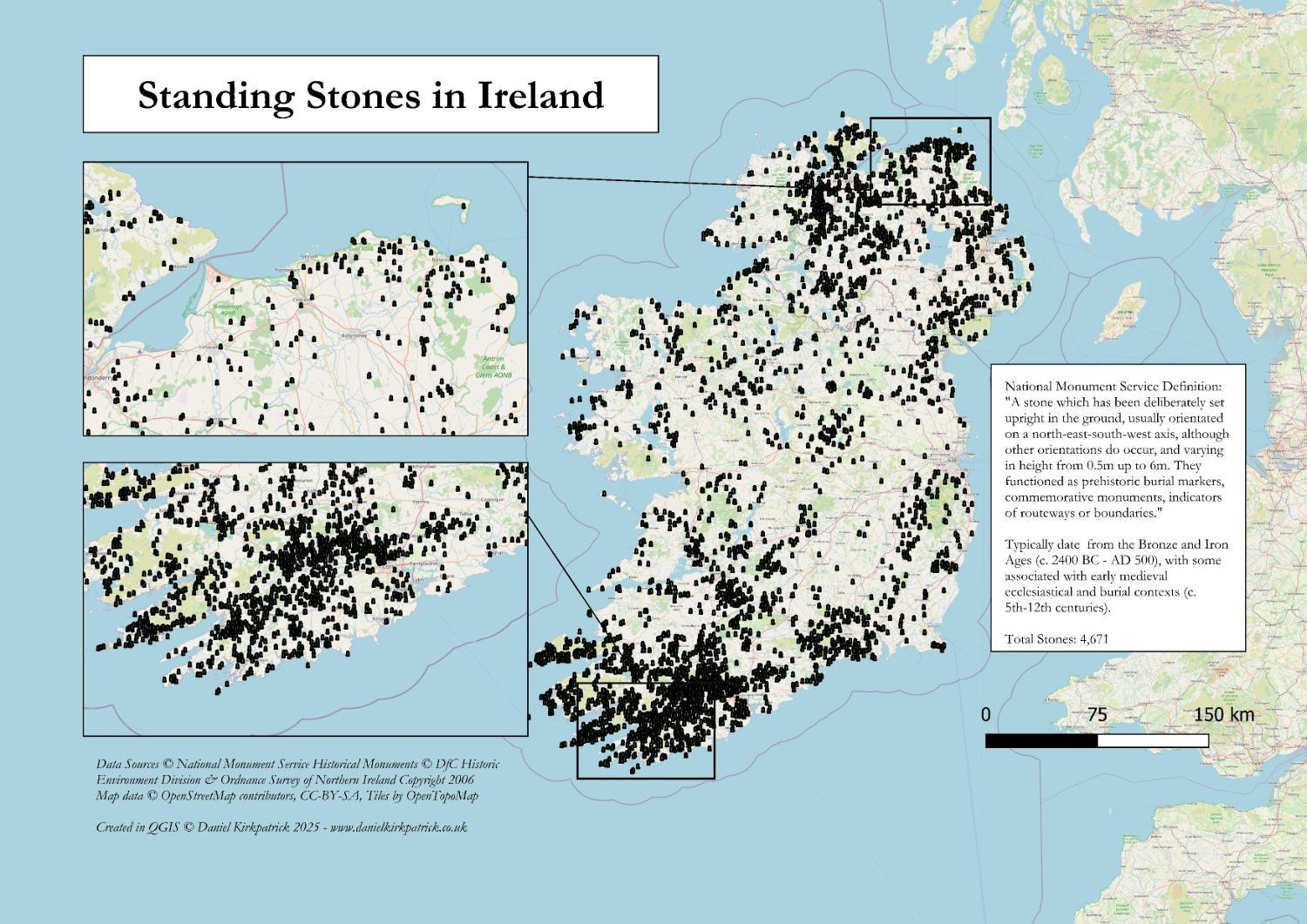Standing Stones Distribution Map of Ireland


David Chen
Data Visualization Specialist
David Chen is an expert in transforming complex geographic datasets into compelling visual narratives. He combines his background in computer science ...
Geographic Analysis
What This Map Shows
The visualization titled "Distribution of Standing Stones in Ireland" provides an overview of the geographical spread of these ancient monuments across the Emerald Isle. Standing stones, often referred to as monoliths, are upright stones that can be found in various shapes and sizes, typically dating back to prehistoric times. This map highlights their locations, allowing viewers to appreciate both their density and distribution throughout Ireland's diverse landscape. The historical and cultural significance of these stones is immense, making their geographical representation a fascinating subject of study.
Deep Dive into Standing Stones
Standing stones are mesmerizing relics of Ireland's prehistoric past. These stones are believed to have served multiple purposes, including religious, ceremonial, and territorial markers. Interestingly, the majority of these stones date back to the Neolithic period, around 4000 to 2500 BCE, and their presence is a testament to the sophisticated societies that once thrived in the region.
What’s fascinating is the sheer variety of standing stones found across Ireland. Some are simple, unadorned slabs, while others boast intricate carvings and designs. The most iconic of these is perhaps the "Druids' Altar" in County Kerry, which exemplifies the artistry and devotion of ancient cultures. In total, it's estimated that there are over 1,000 standing stones scattered throughout the country.
The locations of these stones are not random; they are often situated in areas of historical significance or natural beauty. For instance, many stones can be found near ancient burial sites or in alignment with astronomical events, such as solstices. This suggests that ancient peoples had a profound understanding of their environment, using these stones as markers for both spiritual and practical purposes.
Moreover, the standing stones are not just isolated monuments; they are part of a broader landscape of megalithic structures, including passage tombs and stone circles. This interconnectedness of sites highlights the cultural and historical narratives that shaped Ireland’s ancient societies. Archaeological studies suggest that the placement of these stones was intentional, often aligning with other sites to create a network of spiritual and cultural significance.
Regional Analysis
When examining the map of standing stones, it becomes evident that certain areas are particularly rich in these ancient structures. For example, counties like Kerry, Cork, and Donegal are notable hotspots. In County Kerry, the "Kerry Head" area features a concentration of standing stones, each telling a story of the past. Interestingly, the stones in this region often show signs of weathering, indicating their exposure to the elements for millennia.
In contrast, areas like Dublin and its surroundings have fewer standing stones, likely due to urban development and the historical changes in land use. This discrepancy raises questions about how modern society interacts with ancient heritage. Have you noticed that urban growth often leads to the neglect of historical sites? The balance between preservation and development continues to be a pressing issue in many regions.
Furthermore, the map reveals that the distribution is not uniform. Some counties, such as Antrim and Armagh, display a unique alignment of standing stones that suggests a deliberate placement, possibly related to local beliefs or customs. For instance, the stones in Antrim are often found near ancient cairns, indicating a possible connection between burial practices and the standing stones themselves.
Significance and Impact
The significance of standing stones extends beyond their historical and cultural implications; they also play a vital role in contemporary society. These structures attract tourists and researchers alike, contributing to local economies and fostering a sense of community identity. The preservation of standing stones is crucial, as they serve as tangible links to Ireland's rich heritage.
Moreover, as awareness grows regarding the importance of cultural heritage, there is an increasing push for conservation efforts. Many organizations are working tirelessly to protect these ancient monuments from environmental degradation and urban encroachment. Interestingly, some communities are now incorporating standing stones into educational programs, teaching younger generations about their heritage and the stories these stones tell.
In conclusion, the distribution of standing stones across Ireland is not just a geographical curiosity; it is a window into the past, reflecting the beliefs, practices, and artistry of ancient societies. As we continue to explore and understand these remarkable structures, we not only honor our history but also ensure that future generations can appreciate the stories etched in stone.
Visualization Details
- Published
- October 18, 2025
- Views
- 30
Comments
Loading comments...